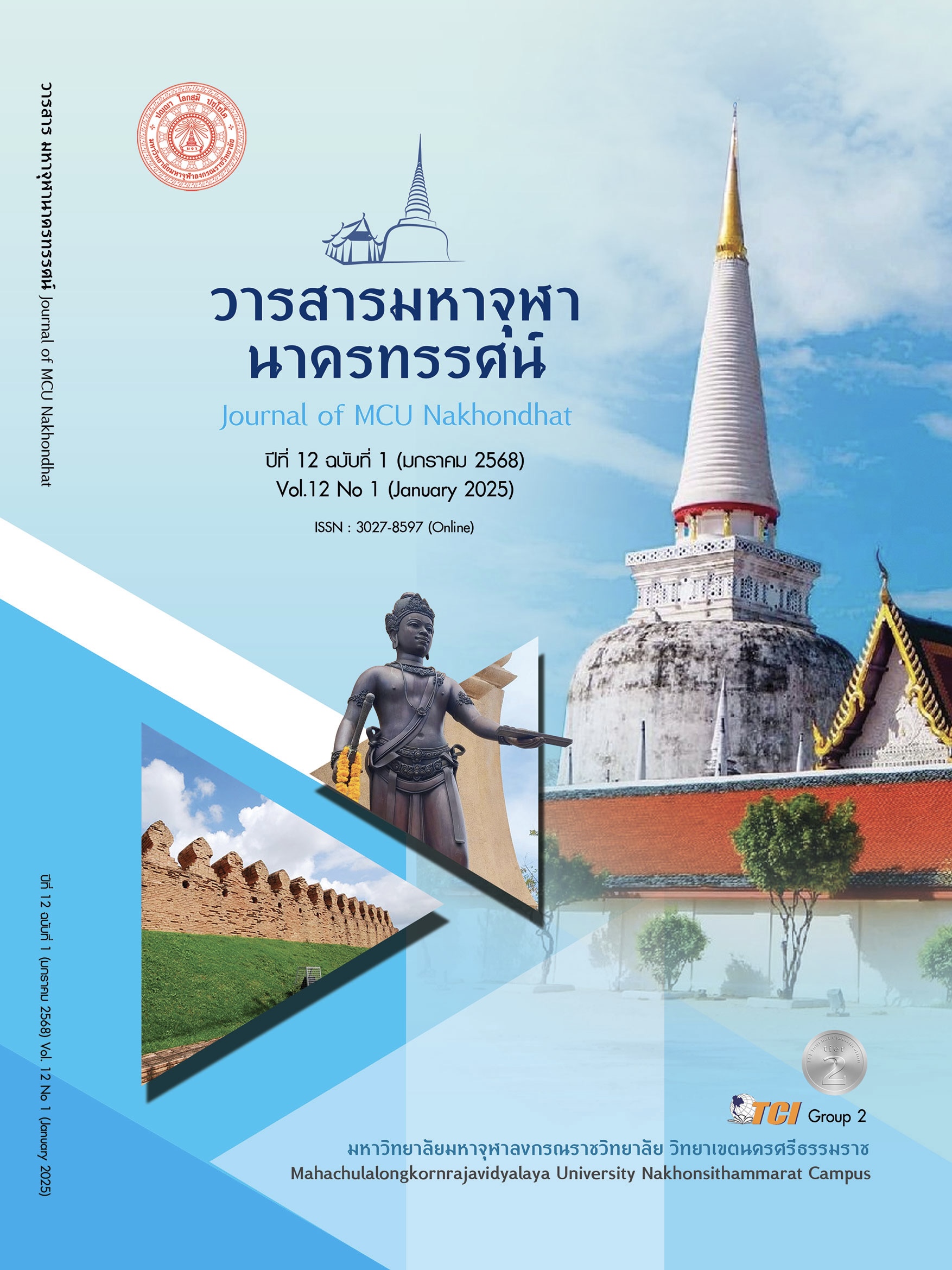APPLICATION OF THE SEVEN PRINCIPLES OF SAPPAYA TO PROMOTE THE QUALITY OF LIFE OF THE ELDERLY
Main Article Content
Abstract
Currently, Thailand has completely entered into an aging society. This is because factors such as population structure, economics, society, politics, and technological progress have come to play a role in the quality of life of Thai people. Especially the quality of life of the elderly society. Economic and social progress This causes the population structure and lifestyle of Thai people to change as well. Quality of life of the elderly is that the elderly is satisfied with their daily life appropriately in 4 areas: physical health, mental health, social relationships. and environmental. The seven principles of Sappaya include: 1) Arvas Sappaya, a comfortable place to live; 2) Kojara Sappaya, the village is comfortable; 3) Passa Sappaya, words that are comfortable; 4) Pukkala Sappaya, the person is comfortable. 5) Phochana Sappaya, Food is comfortable. 6) Utu Sappaya, the weather is comfortable, and 7) Iriyapatha Sappaya, the posture is comfortable. Application of the Seven principles of Sappaya to apply in real life of the elderly, especially both physically and mentally which is an important aspect for the elderly. That is, applying Dhamma principles to the lives of the elderly which in daily life. All 7 comforts must be taken into account, which is to get a suitable place for relaxation. Traveling is convenient. Negotiating with people who want, having friends who think about helping and supporting each other, having food that you can eat without getting bored, having pleasant weather or atmosphere and having done the physical exercise whether it is standing, walking, sitting, or lying down appropriately, it is one option that will ultimately give the elderly a better quality of life.
Article Details

This work is licensed under a Creative Commons Attribution-NonCommercial-NoDerivatives 4.0 International License.
References
กรมกิจการผู้สูงอายุ. (2552). สถานการณ์ผู้สูงอายุไทย พ.ศ. 2552. เรียกใช้เมื่อ 25 มีนาคม 2567 จาก https://www.dop.go.th/download/statistics/knowledge_th_20161905135655_1.pdf
กัลยาณมิตร. (2560). การดูแลสุขภาพในพระไตรปิฎก. เรียกใช้เมื่อ 26 มีนาคม 2567 จาก https://kalyanamitra.org/th/article_detail.php?i=14391
ไทยรัฐออนไลน์. (2566). 10 อันดับ จังหวัดที่มีผู้สูงอายุมากที่สุดในประเทศไทย. เรียกใช้เมื่อ 25 มีนาคม 2567 จาก https://www.thairath.co.th/lifestyle/lifestyle45plus/2731867
นวรัตน์ ปัญจธนทรัพย์. (2563). การพัฒนาคุณภาพชีวิตของผู้สูงอายุที่ต้องพึ่งพาตนเองในเขตอำเภอบ้านโป่ง จังหวัดราชบุรี. ใน รายงานสืบเนื่องการประชุมวิชาการเสนอผลงานวิจัยระดับชาติ ครั้งที่ 8 และระดับนานาชาติครั้งที่ 4 “งานวิจัยและนวัตกรรมเพื่อการพัฒนาสังคมให้ยั่งยืน”. มหาวิทยาลัยกรุงเทพธนบุรี.
พระพรหมคุณาภรณ์ (ป.อ ปยุตฺโต). (2546). พจนานุกรมพุทธศาสตร์ ฉบับประมวลธรรม. (พิมพ์ครั้งที่ 12). เรียกใช้เมื่อ 25 มีนาคม 2567 จาก https://84000.org/tipitaka/dic/d_item.php?i=286
พระพรหมคุณาภรณ์ (ป.อ ปยุตฺโต). (2554). พจนานุกรมพุทธศาสน์ ฉบับประมวลศัพท์. กรุงเทพมหานคร: โรงพิมพ์ บริษัท สหธรรมิก จำกัด.
มหาจุฬาลงกรณราชวิทยาลัย. (2539). พระไตรปิฎกภาษาไทย ฉบับมหาจุฬาลงกรณราชวิทยาลัย. กรุงเทพมหานคร: โรงพิมพ์มหาจุฬาลงกรณราชวิทยาลัย.
สำนักงานกองทุนสนับสนุนการสร้างเสริมสุขภาพ. (2560). 7 ความหมายที่แท้จริงของสัปปายะ. เรียกใช้เมื่อ 26 มีนาคม 2567 จาก https://www.thaihealth.or.th/7-ความหมายที่แท้จริงของ-2/
สำนักงานสถิติแห่งชาติ. (2561). รายงานการสำรวจประชากรสูงอายุในประเทศไทย พ.ศ. 2560. กรุงเทพมหานคร: สำนักงานสถิติแห่งชาติ กระทรวงดิจิทัลเพื่อเศรษฐกิจและสังคม.
สุมณฑา สุภาวิมล. (2565). การประยุกต์หลักสัปปุริสธรรมในการวางนโยบายผู้สูงอายุ. วารสารพุทธนวัตกรรมและการจัดการ, 5(2), 169-182.
สุวัฒน์ มหัตนิรันดร์กุล และคณะ. (2545). แบบคัดกรองทางสุขภาพจิต: เครื่องชี้วัดคุณภาพชีวิตขององค์การอนามัยโลกชุดย่อฉบับภาษาไทย. โครงการจัดทำโปรแกรมสำเร็จรูปในการสำรวจสุขภาพจิตในพื้นที่ ปี พ.ศ. 2545. เชียงใหม่: โรงพยาบาลสวนปรุง.


